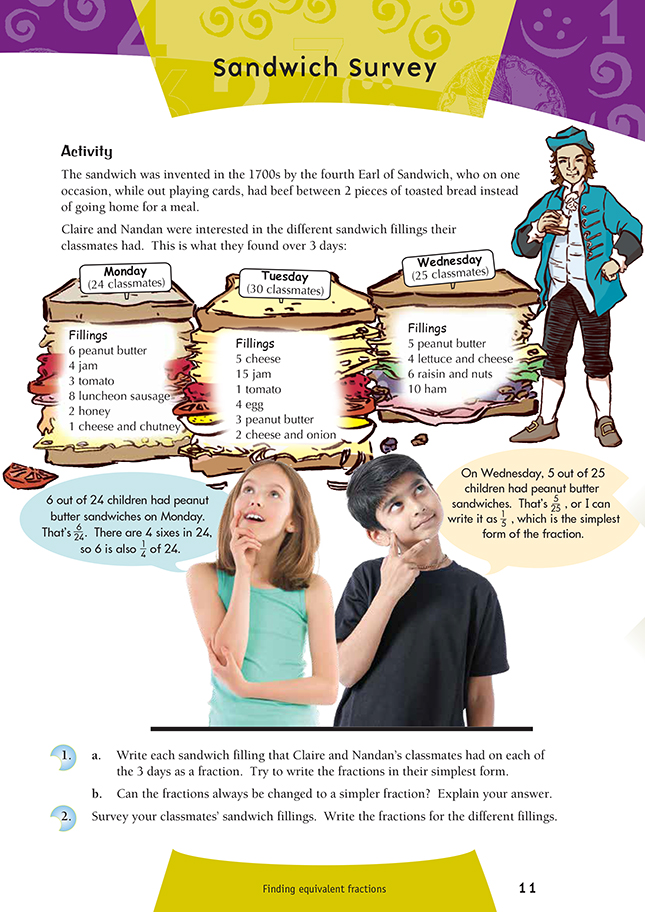This is a level 4 number activity from the Figure It Out series. It relates to Stage 7 of the Number Framework.
A PDF of the student activity is included.
Click on the image to enlarge it. Click again to close. Download PDF (426 KB)
find equivalent fractions
FIO, Level 3-4, Number, Book 2, Sandwich Survey, page 11
The focus of this activity is finding equivalent fractions. It is appropriate for advanced multiplicative students and those in transition to the advanced proportional stage of the Number Framework. For earlier work on equivalent fractions, see Number, Figure It Out, Level 3, page 9 and Number: Book Three, Figure It Out, Level 3, pages 22–23.
Before the students start looking at equivalent fractions, you probably need to check that they understand the meaning of a “whole”, which in this context is Claire and Nandan’s whole class. To reinforce the idea of the whole, you could work through Monday’s list of sandwich fillings with the group or class, writing each filling as a fraction of 24 and then adding the fractions verbally to get 24/24. To help the students in the addition, use tidy numbers, such as complements to 10:
6/24 + 4/24 = 10/24, 8/24 + 2/24 = 10/24; 10/24 + 10/24 = 20/24; 20/24 + 1/24 + 3/24 = 24/24. When adding fractions verbally, students rarely make a mistake: “6 twenty-fourths plus 4 twenty-fourths equals 10 twenty-fourths.” It is in recording that they will try to overrun the addition and add the numerators and denominators to mistakenly give answers like 10/48.
Model the simplification of fractions by initially reminding the students that equivalent fractions are other names for the same amount. For example, “What’s another name for 50/100? 4/8?” (1/2 is the simplest way to express these amounts.)
Look at the two speech bubbles on the page and model the simplification of 6/24. Students with a good grasp of multiplication tables find it easy to generate common factors between the numerator and denominator. “Who can think of a number that is a factor for 6 and 24?” “What multiplication factors equal 6? 24?” At this stage, it is a good idea to list all the common factors, 2, 3, and 6, and then emphasise the usefulness of selecting the largest common factor that the two numbers have
in common (the highest common factor).
Question 1b is designed to reinforce the fact that only fractions with a common factor can be simplified.
Question 2 is a good opportunity to introduce students to statistical investigations or to revise this process with them. The following information can be applied to other investigations in this book, such as those suggested for the activities on pages 14, 18, and 22–23 of the students’ book.
Investigations should develop students’ thinking and their ability to ask questions, as well as to make and test ideas, collect data, develop conclusions, and communicate the results of their mathematical explorations. An investigation is an ideal opportunity for group work. Often students try to be too wide in their approach to conducting surveys and need assistance to define a problem, given manageable amounts of time and resources. Before they start their investigation, discuss the learning outcomes and expectations. Such a discussion can help you develop assessment criteria with the students and provide them with focus and direction. Some things to consider are content, presentation, and participation:
• Is there a clear purpose and conclusion for the mathematical investigation?
• Did the group obtain and use appropriate, reliable information?
• Is the mathematics correct?
• Is the content communicated in a clear and interesting way? (written, oral, graphs, diagrams, use of information technology)
• Is the presentation medium appropriate for the content?
• Did all the group participate?
• Did the group develop its own investigation strategy?
• Was teacher support needed?
• Was the investigation completed during the time allowed?
Not all students will have sandwiches in their lunchboxes, so a category of no sandwiches may need to be created. Also, students may have more than one kind of sandwich per lunch. These students may choose one of their sandwich fillings for the survey, or the “whole” could be changed to focus on the number of sandwich fillings instead of the number of classmates.
The sandwich-filling investigation is easily managed as a whole-class activity and can be linked to objectives in statistics that relate to collecting and displaying data as well as health objectives in food and nutrition.
Answers to Activity
1. a. Monday:
peanut butter: 6/24 or 1/4
jam: 4/24 or 1/6
tomato: 3/24 or 1/8
luncheon sausage: 8/24 or 1/3
honey: 2/24 or 1/12
cheese and chutney: 1/24
Tuesday:
cheese: 5/30 or 1/6
jam: 15/30 or 1/2
tomato: 1/30
egg: 4/30 or 2/15
peanut butter: 3/30 or 1/10
cheese and onion: 2/30 or 1/15
Wednesday:
peanut butter: 5/25 or 1/5
lettuce and cheese: 4/25
raisin and nuts: 6/25
ham: 10/25 or 2/5
b. No. Fractions can only be simplified if the numerator (top number) and the
denominator (bottom number) can be divided by the same number, that is, if they
have a common factor. For example, fractions such as 4/25 cannot be simplified
because the factors of 4 (2 and 4) do not divide evenly into 25.
2. Answers will vary.
